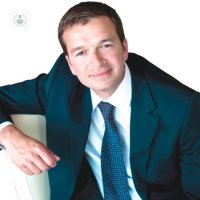Atrial myxoma: an expert's guide to this benign cardiac tumour
Escrito por:Atrial myxoma is the most common of all cardiac tumours, and is often asymptomatic. In his latest article, renowned cardiothoracic surgeon Mr Paul Modi offers his expert insight into this condition.
What is atrial myxoma? What are its symptoms?
Atrial myxoma is a benign tumour that occurs in the heart. It's the most common of all cardiac tumours. It is often asymptomatic. Patients often don't know they have them and have an echo scan for another reason, and then we diagnose the tumour. This is what is called an incidental finding.
Patients can have also symptoms when part of the tumour breaks away and travels through the blood vessels in the body to a different part of the body. The effects or symptoms then depend on where the tumour ends up. If it lands in the brain, it could lead to a stroke. If it goes to the peripheries (fingertips or toes) it can lead to a black area of necrosis, or death of tissue. The effect can either be transient or permanent.
The third effect it can have is what we call constitutional symptoms. They usually tend to be vague symptoms of fevers, night sweats, weight loss, or just not feeling right. It is usually one of those three things: an asymptomatic incidental finding, symptoms from when part of the tumour breaks off, or general constitutional symptoms.
Is this a serious condition?
Yes, it is, or it can be. The danger from myxomas lies in the risk of embolism. Embolism is when something breaks apart and travels through the blood vessels. When a bit of the tumour breaks off and travels to the brain it could cause a stroke, or if it goes to the coronary arteries, it can cause a heart attack. If you have a myxoma, it should be excised to reduce this risk of embolization.
What does minimally invasive myxoma surgery entail?
If you are found to have a myxoma, as I've said, the usual advice is that it should be excised.
There are two ways we can access the heart. In most centres in the UK patients would have a sternotomy, which is where we open the front of the chest. However, this procedure is quite invasive, but it's very safe. As it's essentially a bone fracture, it takes about two to three months for the breast bone to heal. Regardless, you will only be in the hospital for about five or six days. However, you are certainly restricted for at least six weeks afterwards in terms of not doing any heavy lifting.
The alternative to a sternotomy is a minimally invasive procedure. We make a four-centimetre incision on the right-hand side of the chest, in combination with a two-centimetre cut in the groin in order to access important blood vessels. We can then do exactly what we need to do exactly like a sternotomy, but with a closed chest apart from a four-centimetre incision.
This procedure also comes with the advantages of all minimally invasive surgeries, for example, faster recovery, less pain, less wound infections.
Patients are usually back to normal in about three or four weeks rather than three months.
What is the recovery period like after this kind of surgery?
The usual hospital stay is about three or four days from a minimally invasive myxoma resection. This can vary a lot based on the fitness of the patient going into surgery.
Is it not too painful, as we use nerve blocks that numb the right side of the chest wall. Patients typically have a very comfortable postoperative course once at home. As I've already said, recovery is much faster than a sternotomy.
Usually, for the first week at home, you'll need paracetamol, or Tylenol if you're in the US.
After two weeks, the patient is usually in pretty good shape and you just take painkillers as needed.
Does it have a high success rate?
We can measure a success rate in two ways. One way is in terms of operative risk, which is very low. The risk to life is less than 1%, and the risk of a stroke is 1%.
We can also measure the success rate in terms of the recurrence of myxoma. Sporadic myxoma, which is the most common type, has about a 5% chance of recurrence over the course of the patient’s lifetime.
There are certain conditions or syndromes, one of which is called the Carney complex, which causes a genetic predisposition to myxoma. Patients with the Carrney complex also have a much higher chance of recurrence of myxoma.
We've developed a technique called cryotherapy to lower the chance of recurrence. This involves freezing the base of the myxoma down to -150 degrees once we have removed it..
This is done for between two and four minutes and causes an area of scarring of the atrial septum, which is the most common place myxomas arise. This reduces the chance of the myxoma ever coming back.
Mr Paul Modi is a world-renowned consultant cardiothoracic surgeon based in Liverpool and Manchester, with over 25 years of experience. If you are worried about atrial myxoma, you can book a consultation with Mr Modi today via his Top Doctors profile.



